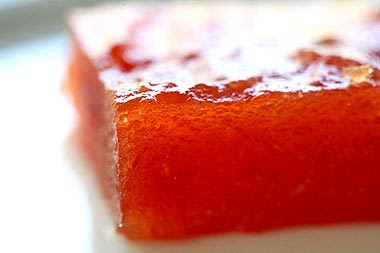Even though this recipe isn't from a Brazilian cookbook it's the best online recipe we've found for marmelada, a extra-thickened quince puree that has been a favorite of Brazilians for nearly 500 years. (Click here to read more about the history of quinces in Brazil).
The quince tree grows well in tropical Brazil, but it also adapts quite happily to temperate climates - climates like those to be found in most of North America and Europe. Quinces were a favorite fruit in the 18th and 19th centuries in these regions, but then fell out of favor for inexplicable reasons, as they are one of the most delicious fruits on Earth. Recently, however, the quince seems to be having a bit of a renaissance, and during late summer and autumn quinces can frequently be found in farmers markets throughout the USA and Canada.
If you're not familiar with quinces, do yourself a favor and make friends with this marvelous fruit. It'll be a long-lasting friendship, guaranteed. A good place to start with the quince (which cannot be eaten raw, unlike most fruits) is this recipe. Once made, this paste can stay in your refrigerator for a very long time (well-wrapped) - just the thing you need when you need a dessert at the last minute. Cut a thick slice of the marmelada, an equal-sized slice of almost any cheese and you're ready to go.
_____________________________________________
RECIPE - Quince Paste (Marmelada)
4 lbs (2 kgs) ripe quinces, washed, peeled cored like an apple, and roughly chopped)
1 vanilla pod, split (optional)
2 - 2 inch by 1.5 inch strips, lemon peel, yellow zest only
3 Tbsp fresh lemon juice
4 cups granulated white sugar (approximate - amount to be determined during cooking)
---------------------------------------------------------------------
In a large sauce pan combine the chopped quince, the vanilla, if using, and the lemon zest. Add cold water to cover and bring to a boil. Reduce heat, cover the pan and simmer the fruit until tender enough to be eaily pierced with a fork, about 30-40 minutes.
Drain the contents of the pan into a colander. Discard the vanilla pod, but leave the lemon zest with the quince. Using a food mill, a blender or a food processor puree the quince and lemon peel into a homogenous pulp, in batches if necessary. When all the fruit is pureed, measure the quantity with a large measuring cup. Whatever quantity you have equals the quantity of sugar you will need.
Put the puree into a large saucepan, preferably non-stick or enameled. Heat to medium-low, then stir in the sugar with a wooden or silicone spoon. Continue to heat, stirring constantly, until the sugar dissolves. Add the lemon juice and stir it in.
Cook over low heat, uncovered, stirring occasionally, until the puree is very thick and has turned a deep rich orange-pink.
Preheat the oven to a very low 125F (50C) - if necessary use an oven thermometer and leave the door open a crack to ensure the low temperature. Meanwhile, line an 8x8 inch (20x20cm) glass baking pan with parchment paper, lightly greased with butter. Pour the puree into the baking pan carefully, using a spatula to spread it around and smooth the top. Place in the warm oven for about an hour, or until the paste becomes quite dry and can be cut with a knife. Remove from the oven and let cool.
To serve, cut into thick slices or wedges and serve with cheese. To store, wrap in fresh parchment paper, then plastic film and store in the refrigerator.
Recipe adapted from simplyrecipes.com
Monday, July 16, 2012
Subscribe to:
Post Comments (Atom)


No comments:
Post a Comment